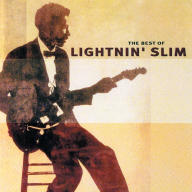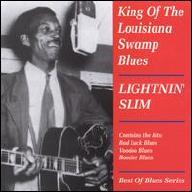He also possessed one of the truly great blues voices, unadorned and unaffected, making the world-weariness of a Sonny Boy Williamson sound like the second coming of Good Time Charlie by comparison. His exhortation to "blow your harmonica, son" has become one of the great, mournful catch phrases of the blues, and even on his most rockin' numbers, there's a sense that you are listening less to an uptempo offering than a slow blues just being played faster. Lightnin' always sounded like bad luck just moved into his home approximately an hour after his mother-in-law did.
He was born with the unglamorous handle of Otis Hicks in St. Louis, MO, on March 13, 1913. After 13 years of living on a farm outside of the city, the Hicks family moved to Louisiana, first settling in St. Francisville. Young Otis took to the guitar early, first shown the rudiments by his father, then later by his older brother, Layfield. Given his recorded output, it's highly doubtful that either his father or brother knew how to play in any key other than E natural, as Lightnin' used the same patterns over and over on his recordings, only changing keys when he used a capo or had his guitar detuned a full step.
But the rudiments were all he needed, and by the late '30s/early '40s he was a mainstay of the local picnic/country supper circuit around St. Francisville. In 1946 he moved to Baton Rouge, playing on weekends in local ghetto bars, and started to make a name for himself on the local circuit, first working as a member of Big Poppa's band, then on his own.
The '50s dawned with harmonica player Schoolboy Cleve in tow, Lightnin' and Schoolboy working club dates and broadcasting over the radio together. It was local disc jockey Ray Diggy Do Meaders who then persuaded Miller to record Lightnin'. He recorded for 12 years as an Excello artist, starting out originally on Miller's Feature label. As the late '60s found Lightnin' working and living in Detroit, a second career blossomed as European blues audiences brought him over to tour, and he also started working the American festival and hippie ballroom circuit with Slim Harpo as a double act. When Harpo died unexpectedly in 1970, Lightnin' went on alone, recording sporadically, while performing as part of the American Blues Legends tour until his death in 1974. Lazy, rolling, and insistent, Lightnin' Slim is Louisiana blues at its finest. ~ Cub Koda, Rovi


















